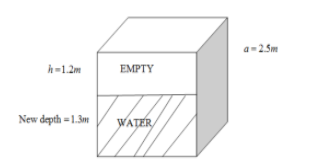
A storage tank is in the form of a cube. When it is full of water, the volume of water is $156.25{{m}^{3}}$ If the present depth of water is $1.3m$. Find the volume of water already used from the tank.\[\]
Answer
570.9k+ views
Hint: We find the side of the cube sized storage tank by taking cube roots of both sides from the formula $V={{a}^{3}}$. We find volume of the cuboid space which emptied after the use of water with depth as difference between side and the new depth $1.3m$. Then we use the fact that $1{{m}^{3}}$of space will contain 1000 litre of water. \[\]
Complete step-by-step answer:
A cuboid is a three dimensional object with six rectangular faces joined by 8 vertices. It has three different types of sides called length, breadth and height denoted as $l,$$b$ and $h$ whose volume is given by$V=lbh$ . A cube is cuboid with condition $l=b=h$.\[\]
The amount space contained by a three dimensional object is measured by the quantity called volume. Let us take the length of the side of the cube as $a$. So the volume of a cube with is
\[V=a\times a\times a={{a}^{3}}..(1)\]
The amount of liquid with unit density is contained in the space by a cube of side of 1 cm is called 1 millilitre(ml). So the 1ml liquid is contained in $1cm\times 1cm\times 1cm=1c{{m}^{3}}$ of space. So So now we find how much liquid is contained in a cube with side 1 metre(m).\[\]
The amount of space contained by a cube of 1m is
\[V=1m\times 1m\times 1m=100cm\times 100cm\times 100cm=100000c{{m}^{3}}\]
We know that 1000ml=1litre. $1c{{m}^{3}}$ of space contains 1 ml of liquid. So $1000000c{{m}^{3}}$ of space will be contained \[\text{1}000000\text{ml}=\dfrac{\text{1}000000}{1000}\text{=1}000\text{ litre}\] of liquid.
We find that a cube with side 1m or $1{{m}^{3}}$of space will contain 1000litre of liquid, in other words 1000litre of liquid will be contained by $1{{m}^{3}}$of space. \[\]
When the cubic tank is full the water will occupy all the volume. It is given that the volume of the cube is $156.25{{m}^{3}}$. We use equation (1) and put the given data
\[\begin{align}
& V={{a}^{3}} \\
& \Rightarrow {{a}^{3}}=156.25{{m}^{3}} \\
\end{align}\]
We take cube root both side and get
\[a={{\left( 156.25{{m}^{3}} \right)}^{\dfrac{1}{3}}}=2.5m\]

So the length of the side is 2.5. Now the depth of the water tank is $1.3m$. So the water used up empties the tank by decreasing the depth (or height)$h=2.5-1.3=1.2m$. The other two sides are $l=b=a=2.5m$. So the volume of the empties by using up the water is
\[ V=lbh=2.3\times 2.5\times 1.2=7.5{{m}^{3}}\]
We know r $1{{m}^{3}}$of space will contain 1000 litre of water. So the amount of water used up is $7.5\times 1000=7500$litre. \[\]
Note: We note that $1{{m}^{3}}$ of space will contain 1000 litre of liquid when the liquid is of unit density. We know that at normal temperature and without any impurity the density of water is $1gm/c{{m}^{3}}$, that means unit density .
Complete step-by-step answer:
A cuboid is a three dimensional object with six rectangular faces joined by 8 vertices. It has three different types of sides called length, breadth and height denoted as $l,$$b$ and $h$ whose volume is given by$V=lbh$ . A cube is cuboid with condition $l=b=h$.\[\]
The amount space contained by a three dimensional object is measured by the quantity called volume. Let us take the length of the side of the cube as $a$. So the volume of a cube with is
\[V=a\times a\times a={{a}^{3}}..(1)\]
The amount of liquid with unit density is contained in the space by a cube of side of 1 cm is called 1 millilitre(ml). So the 1ml liquid is contained in $1cm\times 1cm\times 1cm=1c{{m}^{3}}$ of space. So So now we find how much liquid is contained in a cube with side 1 metre(m).\[\]
The amount of space contained by a cube of 1m is
\[V=1m\times 1m\times 1m=100cm\times 100cm\times 100cm=100000c{{m}^{3}}\]
We know that 1000ml=1litre. $1c{{m}^{3}}$ of space contains 1 ml of liquid. So $1000000c{{m}^{3}}$ of space will be contained \[\text{1}000000\text{ml}=\dfrac{\text{1}000000}{1000}\text{=1}000\text{ litre}\] of liquid.
We find that a cube with side 1m or $1{{m}^{3}}$of space will contain 1000litre of liquid, in other words 1000litre of liquid will be contained by $1{{m}^{3}}$of space. \[\]
When the cubic tank is full the water will occupy all the volume. It is given that the volume of the cube is $156.25{{m}^{3}}$. We use equation (1) and put the given data
\[\begin{align}
& V={{a}^{3}} \\
& \Rightarrow {{a}^{3}}=156.25{{m}^{3}} \\
\end{align}\]
We take cube root both side and get
\[a={{\left( 156.25{{m}^{3}} \right)}^{\dfrac{1}{3}}}=2.5m\]

So the length of the side is 2.5. Now the depth of the water tank is $1.3m$. So the water used up empties the tank by decreasing the depth (or height)$h=2.5-1.3=1.2m$. The other two sides are $l=b=a=2.5m$. So the volume of the empties by using up the water is
\[ V=lbh=2.3\times 2.5\times 1.2=7.5{{m}^{3}}\]
We know r $1{{m}^{3}}$of space will contain 1000 litre of water. So the amount of water used up is $7.5\times 1000=7500$litre. \[\]
Note: We note that $1{{m}^{3}}$ of space will contain 1000 litre of liquid when the liquid is of unit density. We know that at normal temperature and without any impurity the density of water is $1gm/c{{m}^{3}}$, that means unit density .
Recently Updated Pages
Master Class 12 Business Studies: Engaging Questions & Answers for Success

Master Class 12 Economics: Engaging Questions & Answers for Success

Master Class 12 English: Engaging Questions & Answers for Success

Master Class 12 Maths: Engaging Questions & Answers for Success

Master Class 12 Social Science: Engaging Questions & Answers for Success

Master Class 12 Chemistry: Engaging Questions & Answers for Success

Trending doubts
Which places in India experience sunrise first and class 9 social science CBSE

Fill the blanks with the suitable prepositions 1 The class 9 english CBSE

Write the 6 fundamental rights of India and explain in detail

Difference Between Plant Cell and Animal Cell

What is pollution? How many types of pollution? Define it

What is the full form of pH?




